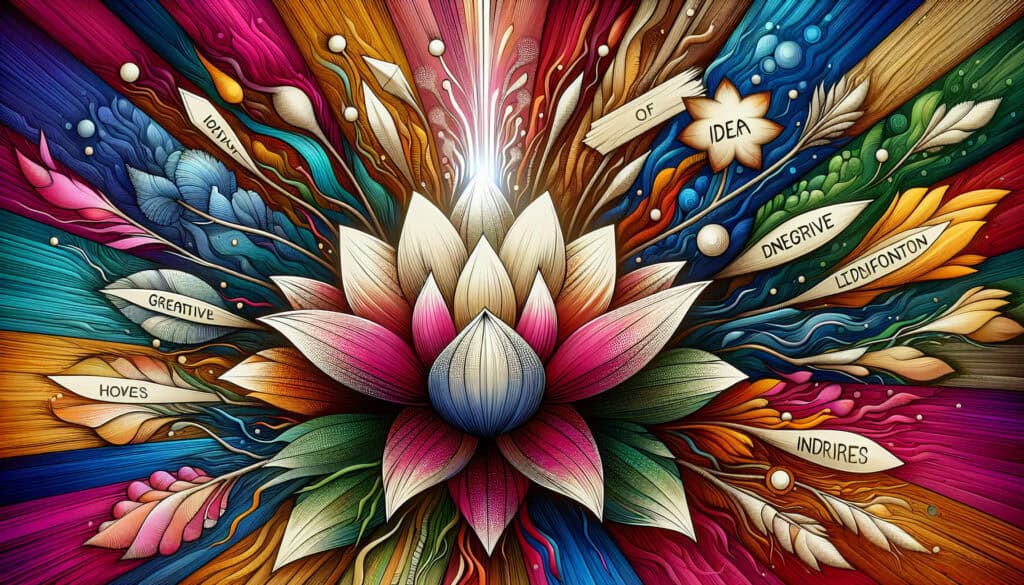Eine große Anzahl von Ideen auf strukturierte und kreative Weise zu generieren.
- Methodologien: Kunden & Marketing, Wirtschaft, Lean Sigma, Herstellung, Projektmanagement, Qualität
Lotusblumentechnik

Lotusblumentechnik
- Agile Methodik, Brainstorming, Kreativität, Funktionsübergreifende Zusammenarbeit, Entwurfsprozess, Design Denken, Ideenfindung, Innovation, Benutzerzentriertes Design
Zielsetzung:
Wie es verwendet wird:
- A brainstorming technique that starts with a central theme and branches out into related ideas. The central theme is placed in the center of a 3x3 grid, and the surrounding squares are filled with related ideas. Each of these ideas then becomes the center of a new grid, creating a 'blossom' of ideas.
Vorteile
- Generates a large number of ideas in a structured manner; Encourages deep exploration of a topic.
Nachteile
- Can be time-consuming; The quality of ideas can be variable.
Kategorien:
- Ideenfindung, Problemlösung
Am besten geeignet für:
- Exploring a central theme or problem from multiple perspectives to generate a wide range of creative ideas.
The Lotus Blossom Technique is particularly effective during the concept generation phase of product design and innovation, where teams from engineering, design, marketing, and even end-users come together to explore ideas and solutions for a given challenge. This methodology is widely utilized in industries such as consumer electronics, automotive design, software development, and healthcare, where multi-faceted problems require creative thinking from various angles. Participants in these sessions often include cross-disciplinary teams to ensure diverse viewpoints, such as engineers who focus on functionality, designers who prioritize aesthetics, and marketers who understand customer needs. As ideas blossom out from the central theme, each new branch can represent different attributes, customer needs, technological capabilities, or market trends, allowing groups to collectively examine each aspect without becoming overwhelmed. The cyclical nature of the technique encourages revisiting earlier ideas to refine and expand them further, making it easier to identify innovative solutions that might not have been considered initially. This method also reduces the pressure on individuals by allowing them to contribute in a less linear fashion, fostering an environment where iterative collaboration can lead to breakthroughs in product features or new market opportunities.
Die wichtigsten Schritte dieser Methodik
- Identify the central theme or problem and write it in the center of a 3x3 grid.
- Generate related ideas and fill the surrounding squares of the grid.
- Select one surrounding idea and place it in the center of a new 3x3 grid.
- Fill the new grid with ideas related to the selected surrounding idea.
- Repeat the process for each surrounding idea, expanding the grids into new blossoms.
- Review and refine the ideas generated from all grids as needed.
Profi-Tipps
- Encourage cross-disciplinary participation by inviting experts from various fields, ensuring diverse perspectives enrich the brainstorming process.
- Utilize digital tools to facilitate real-time collaboration and idea documentation, allowing for seamless integration of contributions from remote teams.
- After the initial rounds of idea generation, implement targeted iteration sessions that focus on refining and developing the most promising concepts from the grids.
Verschiedene Methoden lesen und vergleichen, Wir empfehlen die
> Umfassendes Methoden-Repository <
zusammen mit den über 400 anderen Methoden.
Ihre Kommentare zu dieser Methodik oder zusätzliche Informationen sind willkommen auf der Kommentarbereich unten ↓ , sowie alle ingenieursbezogenen Ideen oder Links.
Historischer Kontext
1949
1950
1950
1960
1960
1960
1960
1940
1950
1950
1958
1960
1960
1960
1960
(wenn das Datum nicht bekannt oder nicht relevant ist, z. B. "Strömungsmechanik", wird eine gerundete Schätzung des bemerkenswerten Erscheinens angegeben)















Verwandte Artikel
Fragebögen zu muskuloskelettalen Beschwerden
Multivariate Tests (MVT)
Mehrfache Regressionsanalyse
Motion-Capture-Systeme
MoSCoW-Methode
Moods Median-Test